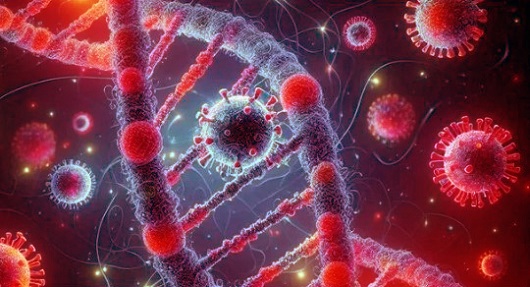New Mutation Emerges in SARS-CoV-2 Nsp13 Protein That Allows Escape from NK Cell Recognition
Nikhil Prasad Fact checked by:Thailand Medical News Team Dec 11, 2024 1 year, 2 days, 19 hours, 54 minutes ago
Medical News: A Novel Mutation Raises Alarm in Global Research
A groundbreaking discovery in the field of immunology has revealed that SARS-CoV-2, the virus responsible for COVID-19, has developed a new mutation in its non-structural protein 13 (Nsp13). This mutation, first identified in the Omicron BQ.1 sub-variant, alters the virus’ ability to evade recognition by natural killer (NK) cells, which are a vital part of the body’s innate immune defense.
 New Mutation Emerges in SARS-CoV-2 Nsp13 Protein That Allows Escape from NK Cell Recognition
New Mutation Emerges in SARS-CoV-2 Nsp13 Protein That Allows Escape from NK Cell Recognition
Researchers from the Karolinska Institutet in Sweden, including the Center for Infectious Medicine and Science for Life Laboratory, spearheaded the study, working alongside experts from various international institutions.
This
Medical News report explores the implications of this mutation, detailing the study's methodology, findings, and broader consequences. As NK cells play a pivotal role in controlling viral infections, any adaptation by SARS-CoV-2 to circumvent this immune response warrants significant attention.
Unpacking the Mutation
The mutation, identified as a methionine-to-isoleucine substitution at position 2 (pM2I) in the HLA-E-restricted Nsp13232-240 epitope, affects how the virus’ peptide binds to HLA-E molecules. This binding process is essential for the immune system to detect and combat infected cells. The mutated epitope shows reduced binding stability to HLA-E, a protein crucial for presenting viral peptides to NK cells. This impaired binding enables the virus to evade immune detection by increasing the inhibitory signals to NK cells, effectively dampening their response.
The researchers employed a combination of cellular assays and advanced structural analysis using X-ray crystallography to confirm these findings. They noted that the mutation changes the occupancy of the HLA-E B-pocket, which is pivotal for the peptide’s presentation. As a result, the mutated epitope’s interaction with NK cells via the NKG2A receptor shifts, favoring immune evasion.
Viral Fitness and Evolution
Another key aspect of the study is the enhanced viral fitness associated with the mutation. Using computational models, researchers assessed millions of SARS-CoV-2 genomes and found that the pM2I mutation consistently appears in descendants of the BQ.1 variant. This mutation’s prevalence suggests it offers a competitive advantage, allowing the virus to spread more effectively within human populations.
Interestingly, the study draws parallels between this mutation and peptides found in endemic coronaviruses, such as those causing the common cold. These related viruses exhibit similar adaptations, supporting the hypothesis that SARS-CoV-2 is rapidly evolving under immune pressure.
Implications for Immune Surveillance
The diminished ability of NK cells to recognize and respond to infected cells due to the pM2I
mutation could have far-reaching implications. Natural killer cells are often the first responders to viral infections, attacking infected cells before the adaptive immune system is fully activated. By evading NK cell recognition, SARS-CoV-2 may prolong its survival within the host, increasing the likelihood of severe infection and transmission.
This mechanism also highlights the evolutionary arms race between the virus and the human immune system. The mutation’s emergence underscores the importance of monitoring viral evolution, particularly in the context of innate immunity, which has been less studied compared to adaptive immunity.
Broader Context and Related Findings
The study situates its findings within the broader landscape of coronavirus research. SARS-CoV-2’s closest relatives, such as SARS-CoV-1 and other sarbecoviruses from wildlife, do not exhibit this specific mutation. However, endemic human coronaviruses, like HCoV-OC43 and HCoV-229E, have evolved similar adaptations, possibly over decades of circulating in human populations. These observations suggest that the pM2I mutation represents a rapid evolutionary adaptation within SARS-CoV-2.
Moreover, the study emphasizes how viral peptides that bind to HLA-E can mimic self-peptides, a strategy seen in other viruses like cytomegalovirus (CMV).
However, unlike CMV, which triggers specific immune responses, SARS-CoV-2’s mutation appears to primarily suppress immune activation, offering a distinct pathway for immune escape.
Study Methodology
To explore the effects of the mutation, researchers conducted cellular assays using engineered cell lines and purified NK cells. They loaded these cells with both the original and mutated peptides to compare their presentation and stability. The results consistently showed reduced stability and presentation of the mutated epitope on HLA-E molecules. This reduction correlated with increased inhibition of NK cell activity, particularly in mixed peptide repertoires where viral and self-peptides compete for HLA-E binding.
The team also used in vitro infection models with epithelial cells infected by ancestral and mutated SARS-CoV-2 strains. These experiments revealed that the BQ.1 variant induced significantly lower HLA-E surface expression compared to earlier viral strains. Structural analyses further confirmed these findings, demonstrating how the mutation alters the molecular dynamics of peptide binding.
Conclusions and Future Directions
The discovery of the pM2I mutation in SARS-CoV-2’s Nsp13 protein provides critical insights into how the virus adapts to evade innate immune responses. This mutation represents a sophisticated mechanism of immune escape, allowing the virus to inhibit NK cell activity indirectly by altering peptide presentation.
The implications for public health are profound. As the virus continues to evolve, understanding these adaptations can inform vaccine development and therapeutic strategies. For instance, targeting mechanisms that restore NK cell activity could be a potential avenue for future treatments. Furthermore, the study underscores the importance of integrating innate immunity into broader surveillance efforts, ensuring a more comprehensive understanding of SARS-CoV-2 evolution.
Ultimately, the findings highlight the need for continued vigilance. The rapid emergence of mutations like pM2I demonstrates that SARS-CoV-2 remains a formidable challenge, necessitating ongoing research and innovation to stay ahead in the fight against COVID-19.
The study findings were published in the peer-reviewed journal: PLOS Pathogens.
https://journals.plos.org/plospathogens/article?id=10.1371/journal.ppat.1012755
For the latest COVID1-19 News, keep on logging to Thailand
Medical News.
Read Also:
https://www.thailandmedical.news/news/scientists-warn-a-new-sars-cov-2-lineage-that-will-have-more-mutations-and-pose-challenges-will-likely-emerge-early-2025
https://www.thailandmedical.news/news/study-reveals-neurological-dangers-of-mild-omicron-subvariants
https://www.thailandmedical.news/articles/coronavirus
